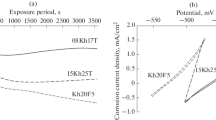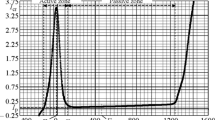Features of the effect of both individual and combined alloying with nitrogen, molybdenum and silicon of unstabilized cold-worked and heat-treated austenitic Cr–Ni and Cr–Mn–Ni steels on pitting and intercrystalline corrosion (ICC) resistance in weakly oxidizing media are studied. On the basis of corrosion and electrochemical test results (electrochemical method), an ambiguous effect of alloying cold worked Cr–Mn–Ni steels with nitrogen and molybdenum on pitting corrosion resistance is revealed. It is established that a necessary condition for intergranular corrosion resistance of chromium-nickel steels after prolonged tempering at 550–750°C is the presence of silicon in addition to nitrogen and molybdenum, which participates in improving the passivity of chromium-depleted boundary zones. Silicon added to nitrogen-containing steel alloyed with molybdenum and 0.03 wt.% carbon with a balanced content of Cr, N, Mo and Si facilitates an improvement of passivity for boundary zones impoverished in chromium. Introduction of silicon into nitrogen-containing chromium-nickel steel (0.03% C) alloyed with molybdenum with a balanced content of Cr, Ni, Mo, and Si makes its ICC resistance equal to specially low-alloy stainless steel containing 0.003% C.




Similar content being viewed by others
References
E. A. Ul’yanin, T. V. Svistunova, and F. L. Levin, High-Alloy Corrosion-Resistant Steels, Metallurgiya, Moscow (1987), pp. 39–41.
E. G. Fel’gandler, N. A. Sorokina, T. V. Svistunova, and F. A. Levin, “Contemporary corrosion-resistant steels and alloys for media of different corrosiveness,” in: Contemporary Metallurgy Problems, Metallurgiya, Moscow (1983), pp. 160–168.
T. V. Svistunova, A. P. Shlyamnev, B. S. Litvak, and N. G. Danovskii, Patent 2288967 RF, C22C38/54, "Corrosionresistant alloy and object made from it," subm. 04.15.2005, publ. 12.10.2006.
A. P. Shlyamnev, “Nitrogen-containing stainless steels – structure, properties, manufacturing and application prospects,” Probl. Chern. Met. Meterialoved., No. 1, 53–60 (2007).
A. P. Gulyaev and L. A. Pisarevskii, “Study of the properties and industrial trial of new high-strength low-magnetic steel,” in: High-Strength Nonmagnetic Steels, Nauka, Moscow (1978), pp. 186–191.
A. A. Pisarevskii, “Low-magnetic steels for high-strength wire,” in: Structure and Properties of Nonmagnetic Steels, Nauka, Moscow (1982), pp. 194–197.
L. A. Chigirinskaya, G. P. Chernova, and N. D. Tomashov, “Corrosion behavior of chromium-nickel-molybdenum steel with nitrogen,” Zashchita Met., XX, No. 3, 404–407 (1984).
L. A. Pisarevskii and S. A. Golovanenko, “Structure and properties of stainless steels with nitrogen and molybdenum,” Proc. Conf. New in Materials Science and Heat Treatment of Metals and Alloys, Chelyabinsk, NIIM, June 1983, pp. 6–8.
S. A. Golovanenko and L. A. Pisarevskii, “Corrosion-resistant steels for high-strength cables and wire,” in: Problems of Contemporary Metallurgy, Metallurgiya, Moscow (1983), pp. 153–159.
L. A. Pisarevskii, D. V. Aparin, E. A. Ul’yanin, et al., “Effect of nitrogen and molybdenum on nonmagnetic steel resistance to hydrogen cracking,” in: New Special Steel Manufacturing Technology, TsNIIChM, Elektrostal Plant, Moscow (1990), pp. 133–136.
S. A. Glazkova, G. L. Shvartz, L. I. Freiman, and F. N. Tavadze, “Study of the local corrosion resistance of chromium-nickel steels alloyed with molybdenum and silicon,” Zashchita Met., 10, No. 1, 9–16 (1974).
T. V. Svistunova and N. D. Sakuta, “Effect of carbon, silicon, and phosphorus on mechanical properties of steel NM27,” in: Improvement of the Properties of High-Quality Steels due to Alloying and Structure Optimization, Metallurgiya, Moscow (1984), pp. 33–37.
O. V. Kasparov, “Features of intercrystalline corrosion of silicon-containing austenitic stainless steels,” Zashchita Met.. 40, No. 5, 475–481 (2004).
L. Ya. Savkina and E. G. Fel’gandler, “Effect of alloying on tendency towards intercrystalline corrosion of steel 000X16N15M3,” MiTOM, No. 11, 10–13 (1968).
L. P. Lozovatskaya, I. A. Levin, I. K. Burtseva, et al., “Increase in steel 03Kh18N11 ICC corrosion resistance by adjusting its chemical composition,” Zashchita Met.. 20, No. 3, 411–415 (1984).
O. V. Kasparova, V. M. Mil’man, and S. V. Kostromina, “Question of the mechanism of the effect of silicon on intercrystalline corrosion of tempered austenitic stainless steels,” Zashchita Met., 27, No. 1, 55–63 (1991).
O. V. Kasparova and Yu. V. Baldokhin, “Effect of silicon on the electron structure and corrosion electrochemical behavior of phosphorus-containing steel Kh20N20,” Zashchita Met., 38, No. 5, 463–469 (2002).
A. A. Pisarevskii and I. I. Kaputkin, “Effect of heat treatment for nitrogen-containing corrosion resistant steel on its structure and local corrosion,” in: Optimization of Alloying and Heat Treatment of High Quality Steels, Metallurgiya, Moscow (1987), pp. 31–33.
V. V. Beresovskaya, R. Z. Valiev, and Yu. A. Sokolovskaya, “Mechanism of plasticity and phase stability of austenite alloyed with nitrogen in Cr–Mn–Mo steel with rapid plastic deformation,” Vestn. TGU, 18, No. 4, 1961–1962 (2013).
L. M. Kaputkina, A. G. Svyazhin, and V. G. Prokoshkina, “Dissolution and precipitation of excess phases and distribution of nitrogen between solid solution and nitrides in corrosion resistant steel,” Metally, No. 5, 93 (2006).
E. G. Fel’dgandler and A. V. Plaskeev, “Effect of alloying with Si and Cu on corrosion-electrochemical and mechanical properties of austenitic steel,” MiTOM, No. 10, 12–21 (2003).
L. A. Pisarevskii, D. V. Aparin, E. A. Ul’yanin, et al., Inventor’s Cert. 1571099, IPC5 C22C39/44, "Corrosion-resistant steel," subm. 08.05.1998, publ. 06.15.1990.
L. A. Pisarevskii, I. I. Kaputkin, N. L. Bogatova, et al., “Structure and properties of corrosion resistant steel 30Kh18N4AM3D2S2,” in: Effect of Alloying and Heat Treatment on Properties of High Quality Steels and Alloys, Matallurgiya, Moscow (1985), pp. 30–33.
L. M. Kaputkina, V. G. Prokoshkina, A. G. Svyazhin, et al., “Structure and properties of stainless steel alloyed with nitrogen and copper,” MiTOM, No. 6 (648), 22–28 (2009).
L. A. Pisarevskii, D. V. Aparin, E. A. Ul’yanin, et al., Inventor’s Cert. 1694685, IPC5 C22C39/58, "Corrosion-resistant steel," subm. 10.09.1989, publ. 11.30.1991.
Author information
Authors and Affiliations
Corresponding author
Additional information
Translated from Metallurg, No. 8, pp. 59–66, August, 2016.
Rights and permissions
About this article
Cite this article
Pisarevskii, L.A., Filippov, G.A. & Lipatov, A.A. Effect of N, Mo, and Si on Local Corrosion Resistance of Unstabilized Cr–Ni and Cr–Mn–Ni Austenitic Steels. Metallurgist 60, 822–831 (2016). https://doi.org/10.1007/s11015-016-0372-x
Received:
Published:
Issue Date:
DOI: https://doi.org/10.1007/s11015-016-0372-x




